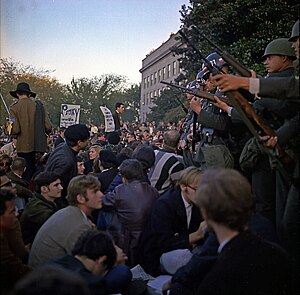March_on_the_Pentagon
March on the Pentagon
1967 American anti-war protest
The March on the Pentagon was a massive demonstration against the Vietnam War on October 21, 1967. The protest involved more than 100,000 attendees at a rally by the Lincoln Memorial. Later about 50,000 people marched across the Potomac River to The Pentagon and sparked a confrontation with paratroopers on guard. The demonstrations were highly polarizing, and also produced the famous photograph of a protester placing flowers in a paratroopers' rifle.[1]
Following a concert by Phil Ochs, as well as speeches from David Dellinger and Dr. Benjamin Spock,[2] around 50,000 of those attending were then led by social activist Abbie Hoffman and marched from the Lincoln Memorial to The Pentagon in nearby Arlington, Virginia to participate in a second rally.[3]
